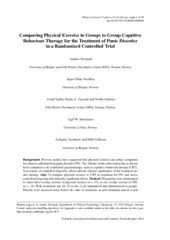Comparing Physical Exercise in Groups to Group Cognitive Behaviour Therapy for the Treatment of Panic Disorder in a Randomized Controlled Trial
Hovland, Anders; Nordhus, Inger Hilde; Sjøbø, Trond; Gjestad, Bente A.; Birknes, Birthe; Martinsen, Egil W.; Torsheim, Torbjørn; Pallesen, Ståle
Peer reviewed, Journal article
Published version
Date
2012-07-05Metadata
Show full item recordCollections
Original version
https://doi.org/10.1017/s1352465812000446Abstract
Background: Previous studies have suggested that physical exercise can reduce symptoms for subjects suffering from panic disorder (PD). The efficacy of this intervention has so far not been compared to an established psychotherapy, such as cognitive behaviour therapy (CBT). Assessment of controlled long-term effects and the clinical significance of the treatment are also lacking. Aim: To compare physical exercise to CBT as treatment for PD, and assess controlled long-term and clinically significant effects. Method: PD-patients were randomized to either three weekly sessions of physical exercise (n = 17), or one weekly session of CBT (n = 19). Both treatments ran for 12 weeks, were manualized and administered in groups. Patients were assessed twice before the start of treatment, at post-treatment and at 6 and 12 months thereafter. Primary outcome-measures consisted of the Mobility Inventory (MI), the Agoraphobia Cognitions Questionnaire (ACQ) and the Body Sensations Questionnaire (BSQ). Results: A two-way repeated measures MANOVA of these measures demonstrated a significant effect of time, F(16, 544) = 7.28, p < .01, as well as a significant interaction effect, F(16, 544) = 1.71, p < .05, in favour of CBT. This finding was supported by the assessment of clinically significant changes of avoidant behaviour and of treatment-seeking one year later. Conclusion: Group CBT is more effective than group physical exercise as treatment of panic disorder, both immediately following treatment and at follow-up assessments.
